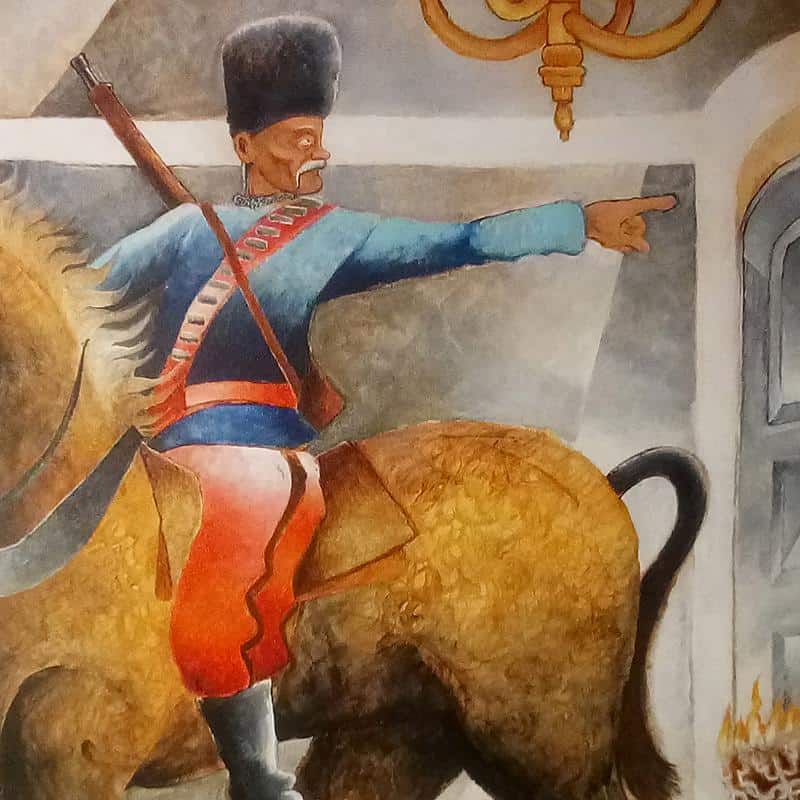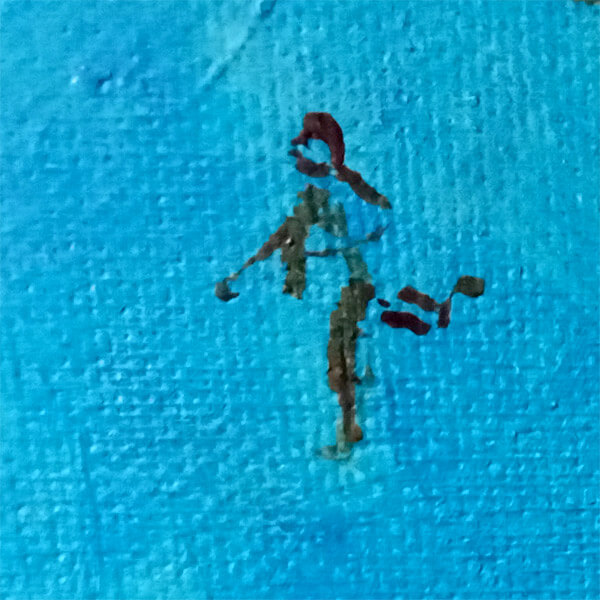A commission for a historical painting
Turka is a small town in Ukraine and became the subject of a specially commissioned historical painting. In 1914 at the beginning of World War I, it was in Polish territory, and occupied by Russian forces. The Stieglitz family was a well-to-do Jewish family with a large house in a prominent position in the town. Unfortunately, it was an ideal place for a military command-post. The Czar’s army sent a troop of Cossacks to requisition the home, possibly knowing they could be relied upon to loot and pillage to their hearts’ content. The Cossacks rode their horses right into the family home, whose parquet floors had always been kept perfectly polished, and whose white tablecloths were always starched and ironed. Of course, the wild horsemen wrecked the place, and the family had to leave. They never forgot the horse-dung on the parquet floor!
Last year, in 2019, one of the descendants of the Stieglitz family was putting the finishing touches to his own newly-built family home in Israel. He wanted to teach his children, in spite of their elegant house, not to invest too much importance in such material things. He asked me if I could make him a historical painting depicting a Cossack horseman evicting his forebears from their home in Turka. This was a challenging task: The subject-matter was quite dramatic and I thought it was probably unappealing for a living-room painting, especially as the horse and rider were supposed to be dominant. However, taking it on was also a way for me to break out from my well-honed children’s illustrative style, and perhaps move into more expansive artistic realms.
As a starting point, I looked online for historical paintings or photos of Cossacks, paintings of horsemen in general, paintings of horses, and photos of the town of Turka. I made composite collages in Photoshop with some of the images I’d found and these reminded me of work by Peter Doig but I couldn’t find an approach that suited both my own style as well as what my patron was looking for. I loved the wonderful horsemen of Raoul Dufy. I used something of their colouring in the sketches but in the end this didn’t fit with the spirit of this project. Eventually I settled into the artistic world of 1914 itself, of Eastern Europe and its Jewish life, through the inimical lens of Marc Chagall. I re-read parts of his amazing, poetic autobiography, and looked at lots of his early artwork on life in his hometown of Vitebsk and in the countryside around. Gradually this new historical painting seemed to make more sense in terms of composition, colouring and subject-matter.
I received the following special comment about this picture: “…….there’s something about the interplay of harsh history with the naive warmth that is striking and powerful.” D.T., Jerusalem, Israel
טורקה היא עיר קטנה באוקראינה. בשנת 1914 בתחילת מלחמת עולם הראשונה היא הייתה בשטח פולין ובידיהם של כוחות רוסיים. משפחת שטיגליץ הייתה משפחה יהודית אמידה עם בית גדול במיקום בולט בעיר. לרוע המזל, זה היה מקום אידיאלי לעמדת פיקוד צבאי. צבא הצאר שלח קבוצת קוזאקים להשתלט על הבית. הקוזקים רכבו על סוסיהם היישר לבית המשפחה, שרצפות הפרקט שלו תמיד היו מלוטשות בצורה מושלמת, וששולחן האוכל שלה היה תמיד מכוסה במפה לבנה מעומלת ומגוהצת . כמובן, שהפרשים הפראיים הרסו את המקום, והמשפחה נאלצה לעזוב. הם מעולם לא שכחו את גללי הסוסים על רצפת הפרקט
בשנה שעברה, בשנת 2019, אחד מצאצאי משפחת שטיגליץ סיים לבנות את בית משפחתו החדש בארץ. בגלל הטראומה שעברה משפחתו בטורקה הוא רצה ללמד ולהדגיש לילדיו, שלמרות ביתם האלגנטי, לא כדאי להשקיע חשיבות רבה מדי בדברים חומריים כי כפי שהוא יודע הדברים יכולים להתהפך בשנייה. הוא שאל אותי אם אוכל להכין לו ציור המתאר את פרש הקוזאקי מפנה את אבותיו מביתם בטורקה. כאשר הוא סיפר לי את סיפורו, נזכרתי בסבתא שלי, שהייתה מספרת לנו על זה שהיא הייתה ילדה קטנה שמתחבאת מתחת לשולחן בזמן שהקוזאקים ביצעו פוגרום בכפר שלה. המשימה האמנותית הייתה מאתגרת וכיוון שהנושא היה דרמטי לא הייתי בטוח שהעבודה מתאימה לציור בסלון המשפחתי, אבל קיוויתי שבאמצעותה אוכל להרחיב את השפה האמנותית שלי
חיפשתי תמונות וציורים של קוזאקים, ציורי פרשים, ציורי סוסים ותמונות של העיר טורקה. התמונות שמצאתי שמשו כבסיס לקולאז’ים שהכנתי במחשב. התקשיתי לאתר גישה מתאימה לסיפור הדרמטי של הלקוח. הציור היה חייב להיות רציני, אבל רציתי שיהיה לו גם חיים וצבע. במהלך החיפוש נתקלתי בציורי הפרשים הנהדרים של הצייר הצרפתי ראול דופי . קראתי את האוטוביוגרפיה המדהימה והפיוטית של מרק שאגאל. דרך כתביו של שאגאל ועבודותיו נחשפתי לחיי היהודים במזרח אירופה
התחלתי לחלק את הקומפוזיציה לצורות גיומטריות, ברוח של ה“קוביזם”. בדרך זו נכנס הצבע השחור בהדרגה אל תוכן הציור, והעמיק את תחושת הפחד בסצנה. ריצוף הפרקט המושלם, שהוזכר לעיתים קרובות על ידי הלקוח, התחיל לפתיח חיים חדשים ותרם רבות למתח שבתמונה. בית המשפחה בטורקה שהיה עגול הפך לזירת קירקס ובמרכזה ניצב הרוכב והסוס. ואילו צורתם ומרקמם של צווארו וראשו מתבססים על סוס הנדנדה שהיה לי בילדותי. באופן זה, הסצנה הפכה ל”הופעה”, ולא לתיאור נאמן של האירוע ההיסטורי. אני מקווה שהציור הזה, כקומפוזיציה צבעונית ואפלה מצליח לספר את סיפורה של המשפחה
Record of this historical painting as it developed

סקיצה ראשונה במחשב: רצפת הפרקט והפרש היו אמורים להיות האלמנטים החשובות ביותר

סקיצה שנייה במחשב: הרוכב הוא “הפרש הערבי” של דופי (1914), והרקע הוא מצילום מודרני של העיר טורקה
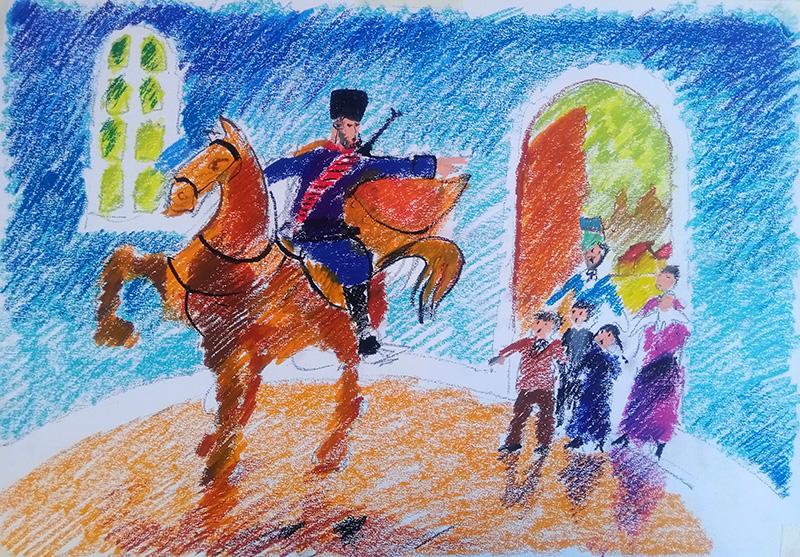
סקיצה 1: פסטל שמן על נייר
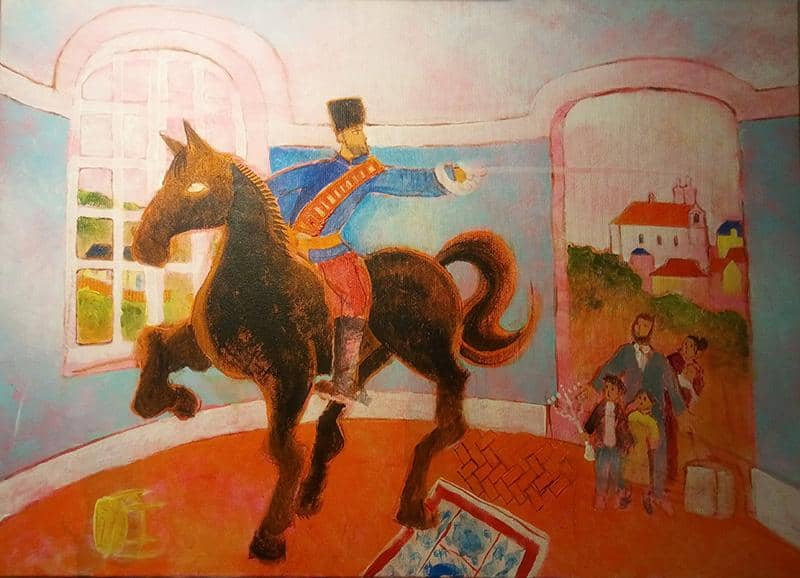
סקיצה 2: אקריליק על בד

אני מתחיל את הציור בסטודיו, עם שתי הגרסאות של הסקיצה ליד
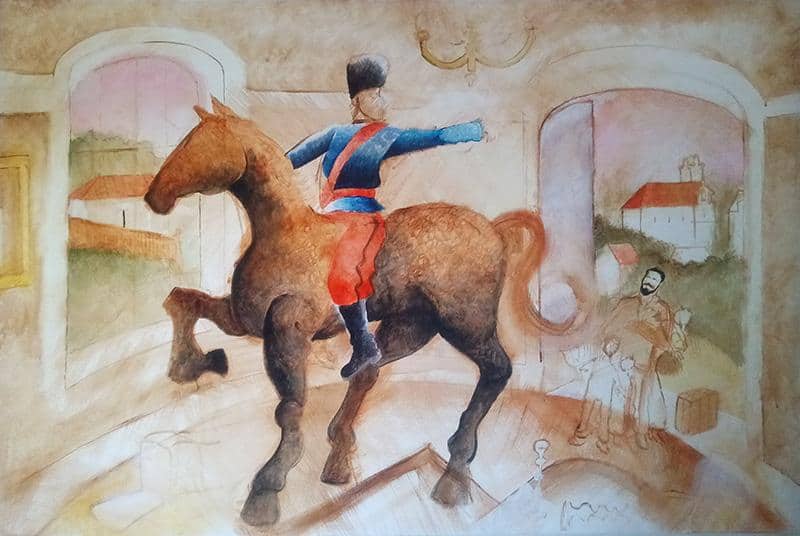
שכבה ראשונה של הציור. רואים את רקע הכללית באומרה שרופה (צבע חום)
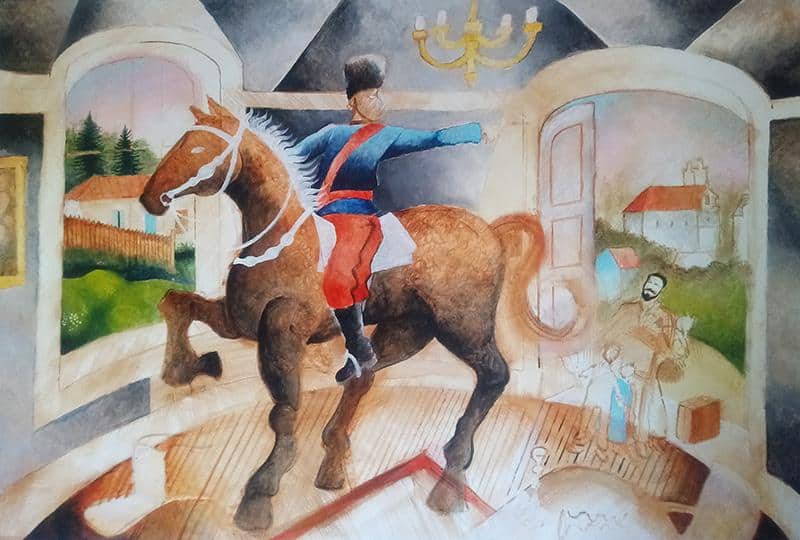
שלב הבא, רואים את הטיפול הגיאומטרי “קוביסטי” ברקע. זה נותן מבנה מארגן, הוא התייחסות לתקופה, ומחדד את הדרמה

אני מחפש גישה אקספרסיבית עבור פניו של הקוזאק. הגרסה האפורה הזו היה נראה לי אגרסיבית ולא אנושית
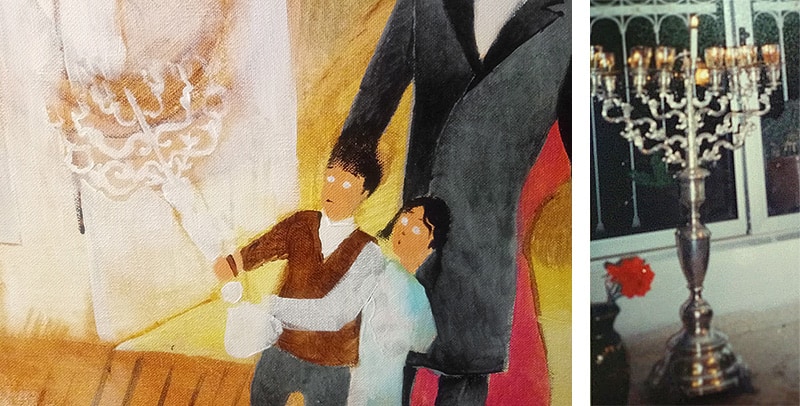
עבודה בתהליך: הילדים מחזיקים בחנוכיה של הוריהם, המשמשת עד היום את צאצאיהם בישראל (מימין)

ציור הסופי, המציג את ביתיה החדש של המשפחה כמודל על אדן החלון – מזכרת מהעתיד. הנוף מבחוץ מבוסס על העיר באמת, כולל הכנסייה
הציור “טורקה”, צבע אקרילי על בד, 100 על 150 ס”מ
I received the following amazing comment about this painting from Daniel Ostrow, in Brooklyn, N.Y :
Timeless ! Ingenious ! Masterpiece ! Palatably yet still accurately reassigns a barbaric, antisemitic home invasion into a delightful and necessarily digestible living-room conversation & center piece ! Brushing in humorous yet humble reaction, the piece triumphantly serves to enhance the happy home ambience rather than to depress it ! A beautiful vibrant perfectly faced amazing piece !
לינק לכתבה במגזין פורטפוליו
Link to article in Jerusalem Post

